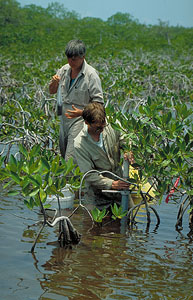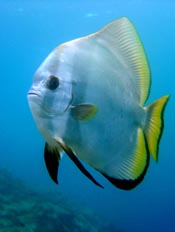Educators

- Scientists studying mangroves. Image courtesy: Carl Hansen
The Ocean and the Sant Ocean Hall intersect with curriculum topics from Biology, Geology, Anthropology, Physics, Weather, and a host of other science themes. When students explore the Hall, they have first-hand access to unparalleled scientific collections of the Museum, as well as ongoing research in marine science.
The Sant Ocean Hall conveys up-to-the-minute science content, and it will inspire your students to explore their connections to the Ocean as citizens and budding scientists. The Sant Ocean Hall and the resources provided here are designed to help your students understand the science of the Ocean through the eyes of scientists. The resources will also help students to make personal connections to the Ocean – no matter where they live – and take the challenge of protecting this invaluable resource as a lifelong Ocean Friend.
For Field Trips
Educators Guide
Engage your students in the search for evidence to address their own questions with guided preparation for their visit to the Sant Ocean Hall. Activities are differentiated for students in grades 4-6, 7-9, and 10-12. Connections to National Science Education Standards and Ocean Science Literacy Principles are included.
Plan a Visit
Find out the logistics of planning a field trip to the Ocean Hall.
The Sant Ocean Hall Family Guide
Created for families to use when visiting the exhibition, the Family Guide can also help to focus students on a field trip to the Sant Ocean Hall. It includes a map and question prompts that students and chaperones can use to make a personal connection to main themes and objects in the Hall.
[ TOP ]
Web-based Student Activities
Coral Reef Interactive
This web-based tool is designed for students to take on the persona of a local resident, a hotel manager, or a tourist. In these roles, they weigh the interdependence between the economic and social impact of human activity and the biological needs of a coral reef and its conservation.
Ocean Friend Challenge
Students can learn how the Ocean’s health relies upon responsible human stewardship. By accepting the Ocean Friend Challenge, they can learn about ways they can have a positive impact on the Ocean’s health and print a certificate to acknowledge their commitment.
Listening for Right Whales
The North Atlantic right whale is one of the most endangered marine mammals in the world, with only 350 surviving. Introduce your students to the work of researchers who use sound recordings to study and help protect these majestic giants and invite them to listen in.
[ TOP ]
Classroom Resources
Tale of a Whale
In this lesson plan from the Fall 2008 issue of Smithsonian in Your Classroom (produced by the Smithsonian Center for Education and Museum Studies (SCEMS) ), students in grades 4-12 meet Phoenix - a North Atlantic Right Whale and the ambassador for the Sant Ocean Hall. Her story lends itself to several engaging activities that help students connect not only to Phoenix as an individual whale but also to the broader issues facing this endangered species.
The North Atlantic Right Whale Catalog
Students exercise their observation skills to do some of the actual work of marine biologists who study the endangered North Atlantic right whale. They examine photographs taken in the field to identify an individual whale, and then examine a record of sighting of the whale in order to track its movements. The North Atlantic Right Whale Catalog, which contains nearly half a million photographs and vital information on some of the remaining members of the species, can supplement the lesson.
Ocean Science at the National Museum of Natural History
Students can explore the marine collections of the Museum, explore field stations where our scientists collect specimens and conduct research, and discover the marine science program.
Ocean Living Photo Gallery
The ocean teems with life—from dazzling green anemones to adorable seal pups. You and your students can take a closer look at a sampling of the incredibly diverse aquatic community in the National Zoo’s Ocean Living Photo Gallery. It includes links to fact sheets about some of the animals featured.
Monterey Bay Aquarium Online Field Guide
The Monterey Bay Aquarium showcases marine life in the Monterey Bay and beyond. With a 28-foot-tall giant kelp forest, sea otters, penguins, and many more marine creatures, it's an excellent place to see ocean wildlife up close. Students can learn about the animals and their habitats through the aquarium’s online field guide.
What You Can Do (for the Ocean)
This list presents some common – and not-so-common – ways for students to learn how they can help preserve the Ocean and its diversity for future generations.
Jellyfish Romance
This article presents the surprising and fascinating reproductive activity of these soft-bodied animals.
Additional Web Resources
The Ocean is a vast expanse, and so are Ocean Education and Ocean Science. These additional resources are available to help you find information about the topics that you teach.
[ TOP ]
[ TOP ]
